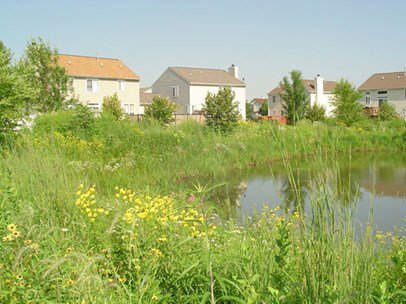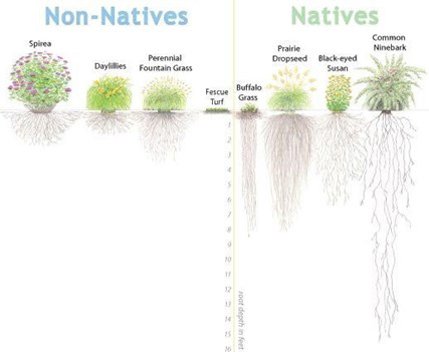
Most of the problems associated with man-made and natural ponds come from planting and mowing turfgrass down to the water’s edge. Because turf grasses originated in Europe, they have not evolved to handle the climate conditions in North America and need “life-support” in the form of constant inputs of water, fertilizer, and pesticides. They also are dependent on activities such as frequent mowing, aeration, dethatching, leaf blowing, and trimming that uses fossil-fueled, air-polluting equipment.
Problems caused by the maintenance of a turfgrass pond border include:
- Algae caused by excess nutrient runoff
- Clippings blown into water
- Lawn chemical runoff
Problems caused by turf grass near ponds include:
- Shoreline erosion
- Siltation/sedimentation
- Duck and goose waste on lawns
- Unpleasing aesthetics
Native Vegetation is the Solution
The deep and fibrous roots of native plants keep soil in place and help channel surface water into soil. When planted as a pond border, they create a buffer to intercept excess fertilizer, pesticides, street chemicals, sand, and silt, and promote the biological uptake of pollutants. The tall stems of native grasses and flowers create a physical barrier to ducks and geese, keeping them away from lawns. Native vegetation requires much less maintenance than turf grass, which, according to a report by the Conservation Research Institute, has been shown to result in a 40 to 50 percent cost savings.

Because native plants co-evolved with native fauna, they attract beneficial pollinators, as well as insects and birds that eat mosquitoes. Native plantings are more aesthetically pleasing than turfgrasses because of their variety of colors and blooming times. A study from the University of Michigan’s School of Natural Resources and Environment shows that there are physical and mental health benefits to people who spend time around native vegetation.
While native grasses and wildflowers are recommended, woody vegetation, such as trees and shrubs, are not advised for shorelines because they can attract muskrats and beavers. Muskrats will dig through the bank to expose roots that they eat, causing collapse and erosion issues. Beavers can do the same, as well as cutting trees down that may damage buildings or create a hazardous condition.
The experts at Davey Resource Group can evaluate your pond or basin to determine the cause of any problems you may be experiencing and can recommend, install, and maintain cost-saving alternatives to turf.



